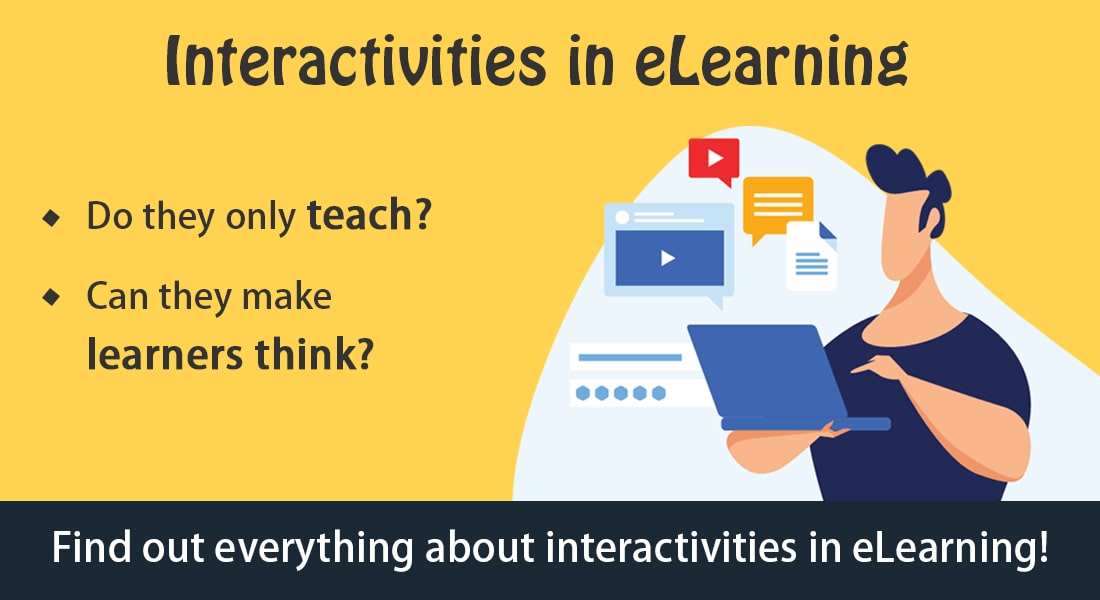Interactivities in eLearning – A Look at the Types

Interactivities in eLearning have a significant impact on the effectiveness and quality of learning. Traditionally, eLearning interactivities referred to learners’ interaction with the course where the learner is expected to do some physical action – click, drag, type, etc. – without really putting their minds to it. But now there is a growing awareness that true interaction needs to be cerebral – answering questions, debating the options of a rhetorical question, recalling prior knowledge, or even empathizing with the character in an unfolding scenario. There are many good reasons to believe that such interactivity substantially affects the learning process, leading to deeper retention and effective learning.
Even face-to-face classroom sessions can put learners to sleep if there are no interactions or activities. So, imagine the plight of learners taking self-paced eLearning courses – without well-designed interactivities!
Making your eLearning modules interactive can:
- Foster active engagement
- Help develop critical thinking skills
- Increase retention
Four Levels of eLearning Interaction
- Passive
- Limited
- Moderate
- Advanced
Before we move on to the types of interactives that can be accommodated in eLearning, let’s take a small detour and look at all the types of learning interactions possible.
Types of Interaction
There are three types of interactions which are proved to be essential for learning and engagement. Out of the three, Learner-Content interactions are applicable to eLearning.
Interactions could be:
- Between Learner – Instructor
- Between Learner – Learner
- Between Learner – Content
Here is a brief on all the three types of interactions:
Learner – Instructor Interaction
This interaction typically occurs in the classroom [either brick n mortar or virtual instructor-led training (VILT)] when the instructor delivers information, guides, or simply encourages the learner. This type of interaction also occurs when the learner clarifies any queries regarding the subject with the instructor.
Because of the ongoing pandemic, VILT, where training is delivered in a virtual/simulated environment has become the go-to format of corporate training, offering all the benefits of face-to-face classroom training, virtually!
Here is everything you need to know to get started with VILT.
Learner – Learner Interaction
This interaction happens between two learners or among a group of learners. Though this interaction happens typically in the physical classroom, it can also occur online on the learning management system (LMS) among learners taking the same module – through discussion boards, communication tools, chat rooms, social collaboration tools, and more.
Learner – Content Interaction
These interactions take place when learners obtain information directly from the learning material in self-paced learning modules. To ensure the learner engages effectively with the content, the content has to be easily available and easily consumable. The learner should be able to pause, rewind, repeat, and forward parts of the module as per convenience.
This type of interaction can be achieved by:
- Offering content in various formats including text, images, animations, video
- Creating tasks that require learners to interact with the course content
- Checking their understanding during the module through questions or quizzes
eLearning Interactivities
eLearning courses are generally classified based on the level of interactivity they offer. And the right level of interaction will depend on the learner demographics and the topic. For example, a person who is not very comfortable with the computer may be offered courses with a lower level of interaction, while someone fully conversant with online training may be given more advanced ones. Similarly, while a course on dry facts might need to be gamified to motivate the learner, a simple infographic will suffice to present the dos and don’ts within another course.
Levels of eLearning Interaction:
- Passive
- Limited
- Moderate
- Advanced
Let’s now look at each level of interaction!
Passive Interaction – No Interaction
In this level, the learner does not interact with the course at all. It can be considered basic training where the learner passively receives information. These courses are commonly referred as ‘page-turners’ or ‘click next’ courses. The sequence of screens is fixed, and the learner cannot choose the order in which he/she wants to access the content.
What is included at this level:
- Graphics, simple animations
- Static icebreaker slides
- Basic quiz questions
- Navigation buttons
Limited Interaction
At this level, learners have more control over their learning. This level is used for simple, not very complex operations enabling the learner to interact with multiple-choice questions, drag and drop activities, etc.
Learner interactions at this level include:
- Simple exercises (matching, dragging and dropping)
- Clickable animated graphics
- Open navigation expanding to links, menus, glossaries
- Embedded video snippets
Moderate Interaction
This level has an optimized balance between active learning and application with a high degree of customization of the course. Learners will have more control, can take decisions, perform activities, and more.
Examples of moderate interaction include:
- Scenario-based/simulation-based eLearning
- Courses with gamified elements
- Storytelling
Advanced
This is the highest level of interaction in eLearning, where learners get a feel of the actual work environment through the use of virtual reality or participate in a completely game-based course.
Examples include:
- 3D simulations
- Complex branching scenarios
- AR/VR-based courses
- Game-based modules
To Sum Up
As eLearning professionals, we need to remember that for learning to be effective, learners need to be motivated and encouraged to take the course. Interactivities play a vital role here, giving learners a chance to engage in active cognitive processing.
And here’s where I saved the best for last – new-age engagement strategies. Much like everything in today’s world, eLearning courses are also being rolled out with scale and speed. And that’s possible with rapid eLearning – which offers a lot of scope for learner interaction and engagement.
What you can do to increase learner engagement:
- Address learners by name to offer personalized courses to learners
- Provide digital avatars to guide the learner through the course
- Add icebreakers which address pain points and help reassure learners
- Add comic strips for a bit of humor or emotional connect
- Provide ‘Do you know’ or ‘Do you recall’ questions to lead from the known to the unknown
- Add startling facts or trivia to gain attention
Getting learners to think and engaging them in the course are an indispensable part of eLearning interactions. And don’t forget to include this in your eLearning business case! The flexibility and options afforded by eLearning to make up for the absence of the instructor and make learners active participants in their own learning, will earn it the wholehearted approval of your stakeholders.
For more tips to jumpstart your eLearning adoption, check these e-Hacks!




![The 4 Levels and Examples: Decoding Interactivities in eLearning [Infographic]](https://blog.commlabindia.com/hubfs/Imported_Blog_Media/elearning-interactivities-info.jpg)
